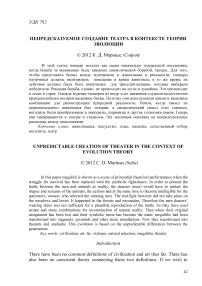Unpredictable creation of theater in the context of evolution theory
Автор: Maritsas Constantinos D.
Журнал: Креативная экономика и социальные инновации @cesi-journal
Рубрика: Социологические и психологические исследования
Статья в выпуске: 2 (3), 2012 года.
Бесплатный доступ
In this paper megalith is shown as a scene of primordial theatrical performances when the struggle for survival has been replaced with the symbolic fight-dance. In order to present the battle between the men and animals as reality, the dancers (men) would have to imitate the shapes and screams of the animals, the actions had at the same time to become intelligible for the spectators, women, who selected the winning men. The real fight however did not take place on the meadows and lawns. It happened in the forests and mountains. Therefore the men dancers’ wearing skins was not sufficient for a plausible reproduction of the battle. So they have used stones and stone combinations for reconstruction of natural reality. Then when their original assignment has been lost and their symbolic sense has become the main, megaliths had been transformed into ziggurats, pyramids and other stone installations. Now they transformed into theaters and stadiums. This evolution is based on the unpredictable differences between the generations.
Civilization, art, lie, violence, natural selection, megaliths, theater
Короткий адрес: https://sciup.org/14238931
IDR: 14238931 | УДК: 792
Текст научной статьи Unpredictable creation of theater in the context of evolution theory
There have been no common definitions of civilization and art thus far. There has also been no consistent theory connecting these two definitions. If we wish to define them and to understand the communication between them, it is necessary to track a historical way of human evolution from nature to civilization.
Definition of Civilization
My concept is largely influenced by Darwin’s principle of natural selection, which operates always and everywhere, if we only determine its criteria and scope. Darwin wrote: “I have given this principle, under which each slightest change is retained in case it is useful, the term ‘natural selection’ in order to emphasize its connection with human possibilities, with the possibility of choice” [2, p. 86].
All definitions of civilization we have are anthropocentric: civilization and human activity are identified in them. So we have a vicious circle: civilization=>man, man=>civilization!
According to Darwin, “struggle for life is most severe between individuals and varieties of the same species” [2, p. 99]. Man (male) was doomed to extinction (as other 99% of living beings) for two reasons: first, he was an easy prey for other animals, and, second, due to intraspecific competition for reproduction of new generations. Since his appearance, man is the weakest and most helpless living creature on our planet, but he has the largest brain. There are also many animals that are “biologically weak” too. Yet none of them has created a civilization! And man has survived, creating one! How did he do it?
Only man himself, as is common regarded, thanks to his brain, has abolished the coercive intraspecific competition and consciously terminated the process of natural selection. Having abolished the coercive struggle, man has created a society of similar organisms – human society. But man had to find a substitute for the coercive intraspecific competition, in which male individuals have been selected by women.
So the first step to definition of civilization is the next: “Civilization is replacement of the coercive intraspecific competition with non-violent fights”.
But abolishing the intraspecific competition, man got biologically weak and he became an easier prey for animals. Then he made the second step quite easily, that is, he terminated the coercive fighting with animals.
So the second step to definition of civilization is the next: “Civilization is a replacement of the coercive struggle for survival with a non-violent one”.
Finally I propose definition of civilization which I treat as non-anthropocetric: “Civilization is the survival of the weak”.
This definition can be applied to man, animal and every living being as I will show hereafter.
Definition of Art
According to Whitney Davis “So far it might seem that we have not learned much (beyond the crushingly obvious) about how art looks or what it looks like, aside from being able to say that “this work looks to be art… it looks like art; it has aesthetic aspects”.” [3, p. 5].
Now let us consider definition of art. All definitions of art (as well as civilization) we have are anthropocentric: art and human activity are identified in them. And we have one more vicious circle: art=>man, man=>art!
If we consider H. Taine’s words: “With time they [men – C.M.] actually make copies of the copies …” we could define art as the process of the creation of “copies of the copies of nature”, made by males to be chosen by females for reproduction. In this case I use “male” (not “man”) and “female” (not “woman”) intentionally for obtaining not anthropocentric definition. The necessity of art induced appearance of male’s fantasy.
The definition of art given above contains two preconditions for the art. The first one requires the original type to be natural. Art requires copying of nature. The second prerequisite is the goal of art. The goal of art is the survival of the every next generation: “However, as you already know, the artist (the male – C.M.) creates in order to be valued and adored (by the female – C.M.). This is the passion dominating in him” [17, p. 52]. The “passion” in this case is his “instinct of reproduction”.
One of the first confirmations of the definition of art is: “Labour does not create, of course, pieces of art, even when the product of physical work can distinguish itself from the industrial product” [9, p. 96]. Apparently labour is a copy of copies from nature, but the goal is not the survival of the species. The goal of hand-labour is the survival of the male as an individual. And here two goals of each living being could be spotted: the survival of the species (in the case of art) and that of the individual (in the case of labour). Work clothes are a product of labour (manual labour), the evening outfit or the suit, however, are pieces of art.
In order that the “man of labor” could be distinguished from the “man of art”, I will try to give some examples of appropriate jobs:
Labour (survival of the individual) Tailor Bus driver
Аrt
(survival of the species)
Designer
Formula 1 racer
Carpenter Decorator
Worker Sportsman
Painter
Artist
Designers are surrounded by beautiful models, tailors repair torn trousers. Formula 1 racers are subject of admiration; bus drivers are exposed to insults and swearing. It was written in a newspaper that: “Formula 1 seems to act like Viagra. Watching the race makes 45% of British women want to have sex. A great number of women would like to have sex with Formula 1 racers”. Decorators are famous and wanted, whereas carpenters cut timber following the measures. Sportsmen are well-paid for their efforts, whereas workers earn much less for carrying the heavy building materials.
Art leads to the creation of an imaginative reality by men for women. Females perceive the world through the art creations of men; “…for sure the man of art also creates his reality, just like God has created the world” [5, p. 413].
The difference between a piece of art and a piece of labour is evident from the images below (See Fig. 1a, 1b). “A masterpiece taught us what a shoe really is” [9, p. 58].
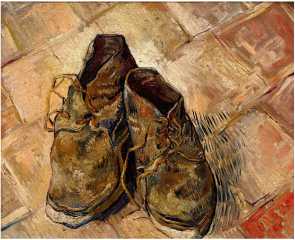
Figure 1a. Van Gogh’s painting (A masterpiece)

Figure 1b. Shoemaker’s product (A basic life need)
Trough art, the “weak” man tried to attract the woman to copulate with her. So to be personal the “artwork” had to bear a “signature”. The woman would recognize the man by the project and pick him. The primitive man, however, did not possess a recognizable signature. That is why he created an art such as cavepainting in inaccessible places, which only he knew. Thereby he tried to enchant the woman there (in his love nest). If he had painted at the cave entrance, the woman wouldn’t have recognized the artist and that meant the goal of art wouldn’t have been achieved. Nowadays men decorate their bedrooms too but not the entrances of their homes.
Concerning the paintings in the caves Dr. Jacob Bronowski wrote: “The only thing we can say seeing the faces of the animals on the walls of the caves is that it is a magic performance” [1, p. 42]. Without explaining what he meant by “magic”, he concluded: "The most important painting of the caves is the imprint of a hand. And the stamp says: This is my sign. I am the Man!” [1, p. 44] (See Fig. 2).
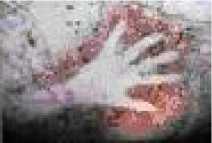
Figure 2. Imprint of the hand - signatures of the primitive weak man.
If Dr. J. Bronowski was exempt from the vague sense of “magic”, he would correctly read the imprint of the hand: “This is my sign. I am the Weak Man. I'm looking for a Woman”.
Some Analogies between Men and Animals, Birds etc. in the Context of Civilization and Art
In my concept, I proceed from the fact that there is no fundamental difference between a man and an animal and definitions of civilization and art can be also applied to animals. Man, due to the peculiarities of his brain, moved first from nature to civilization, replacing the criteria of natural selection by civilizational criteria. This prompted him to create a new visual reality, imitating nature for women with the purpose of reproduction. Many animals and birds also followed the same line (In the book I have quoted examples of the peacock and the toothbilled bowerbird, whose actions cannot be explained from the point of the theory of natural selection). Darwin, using the theory of sexual selection explained the fact that with many species of birds (Guiana mountain thrush, bird of paradise, and some others) males severely compete with each other, attracting females with their singing. Males and females congregate in one place, where the males take turns to spread their brightly coloured feathers, making strange movements and showing off to the females, who act as spectators until they select the most attractive partner. In my opinion, in this case we should not talk about sexual selection, but about the above mentioned civilization criteria.
I will make some analogies with the animal world. In the dance-fight as in nature, in Darwin’s words, “the result should not be the death of the unfortunate rival, but the reduction of his offspring, or the suppression of the possibility thereoff” [2, p. 114]. Thus, the goal is not the death of the rival, but the right to one’s own reproduction. After a series of studies in Serengeti, some American and British scientists have proved that the roar of the king of animals – the lion – carries the necessary information, which aims to avoid unnecessary bloodshed. The lion family is composed of approximately 20 members, mostly females and cubs. The purpose of the females is to bring up and feed the next generation. The presence in the family of one or two males provides the security and reliability of reproduction. Scientists incorporated a recording of another lion’s roars which had to be heard by the female. When females made sure that the alien group was weaker, they reported to their male, who started searching for the invaders’ territory. Studies show that if a family has more than three males, the dispute does not lead to bloodshed.
J. Huizinga writes: “The peacock and the turkey merely display their gorgeous plumage to the females, but the essential feature of it lies in the parading of something out of the ordinary and calculated to arose admiration. If the bird accompanies this exhibition with dance-steps we have a performance, a stepping out of common reality into a higher order. We are ignorant of the bird’s sensations while so engaged” [10, pp. 31-32]. This statement can also bear a relation to the people (See Fig. 3a, 3b).
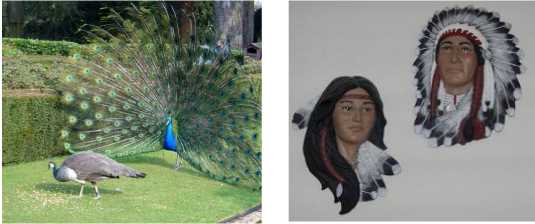
Figure 3a. Peacock male and female.
Figure 3b. Man and woman.
One more interesting analogy can be made here. As M. Marshall noticed, an Australian bird, the tooth-billed bowerbird (Scenopoeetes dentirostris) “every morning knocks specially cut leaves from the tree, turns them so that their pale inner side is in contrast with the ground and thus constructs itself a stage (emphasis added. – C.M.) ... and sings exactly on this stage, perched on a liana or a tree branch” [apud: 4, p. 236] (See Fig. 4a, 4b). G. Deleuze and F. Guattari assume, that “the total work of art is created... by blocks of sensations on the territory – paints, postures and sounds ... In this respect, art will always be obsessed with the animal beginning. It is here that art originated, not only in the treatment of external materials, but also in attitudes and color of bodies, in singing and shouting, which designate territory. This is a whole stream of features, colors and sounds, which are inseparable due to the fact that they are expressive (philosophical concept of the territory)” ]4, p. 236].
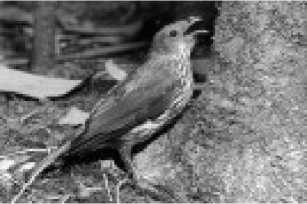

Figure 4a. Scenopoeetes dentirostris. Figure 4b. The “scene” created by scenopoeetes dentirostris.
Initially, man was forced to imitate nature because of the inevitable comparison with natural data – sounds, colors and objects. And the better he did that, the greater was the probability for his being selected for reproduction. Generation after generation of men copied nature, imitated it and unconsciously and inevitably moved away from it. This reflects what Heidegger wrote, “... art is an imitation and representation of reality” [9, p. 61].
Civilization and Natural Selection
Basically in nature the female (woman) chooses the male (man) on the basis of the natural selection principle. As I have already shown in my book “Civilization and natural selection”, civilization imposes the criteria of song (in the sense of melody without words), beauty and property on the female. Initially the male was forced to imitate nature, as the comparison with the natural evidence of sounds, colors and objects was inevitable. The more natural he was, the more likely the opportunity for his reproduction. Generations (male generations) spontaneously copied nature.
However, with life expectancy going up generations started to cover themselves and the impact of their ancestors increased, so gradually, instead of the direct copy of nature, they started to copy indirectly, through the previous generations. “The real” from natural became “traditional”. All the previous generations did was more natural than nature itself. It has always been valid, however, as M. Har wrote that, “…the very final goal of art, is probably nothing but revealing the truth” [7, p. 37]. And here “the truth” has the meaning of “the real”, which from natural became traditional. The influence of the ancestors was so powerful that there came a moment when, “step by step the knowledge of the live model became forbidden. Actually it was not seen any longer and all they knew were the works of the old teachers, they obediently copied. With time they actually make copies of the copies and so on. Each generation drifts away with one degree from the original. Man of art does not have individual inspirations any more; he feels he has simply turned into a copy machine” [17, p. 20].
From the Dance to the Theater
The change in the selection criteria has led to other changes, which exist to the present day.
Women could not directly observe how the process of natural selection went. The hero of the natural selection was the man returning as a winner. The weak men died during inner species struggle or in struggle with predators, so for this reason there were fewer men than women. To survive, and in the capacity of winners copulate with women, was the responsibility of strong men. The process of selection was carried out away from the eyes of the females, i.e. females were not the bystanders of the struggle for survival and the victory of the male who is worthy of reproduction. On the contrary, in the case of “war dances”, the process of selection occurred before the women and, as a rule, in public. Men started parading their qualities, dancing and singing before women.
According to Desmond Morris most of our dances moves come from the same source, but in our case they have not developed into a static ritual kind. They have developed into a human way, i.e., into a civilized way [15, p. 226]. The first generations imitated the nature. But the next ones, instead of imitating nature, began to imitate previous generations, losing the connecting link with nature. By imitating, they lost the main purpose and imitation itself became the main purpose, it became unnatural (“ritual”, “magic” and “religion”) actions.
As the dance became estranged from the real fight, woman had to change her selection criteria. The instinctive cries of pain had to be replaced with acquired ones; the blows had to be replaced with a simple touch. The woman selected the winner on the battlefield or in the sphere of sport or dance, which were a reflection of fight. The rival’s death was not the purpose; rather the right to reproduction was the purpose. So the women had to replace the coercive preponderance criteria with others, civilized ones, to which men have adapted by means of natural selection.
In order for the presentation of the fight between men and animals to be authentic, dancers (men) had to imitate the type of animals for women, who had to select the man-winner. In order to succeed, men wore animal’s skins (bears, wolves, deer, etc.) and roared, thus reproducing animal’s roar. At the same time they had to ‘describe’ the fight. This gave rise to man fantasy. Wearing animal skins for the needs of the dance, men discovered that fur kept warm and offered protection. In this way, clothing for the needs of the dance was the reason for which men lost their fur and invented clothes for everyday use.
Most likely, the first theatrical performances did not have a script, a director, rigid rules and a predetermined pre-finale. It was only the lot of the winner which was known and invariable: he (the man-animal or man-hunter) was obliged to copulate with women (See Fig. 5a, 5b).

Figure 5a Men-animals
Figure 5b Men-hunters.
The source of sexual excitement was not the woman as an object of desire, but the fact of the victory over the rival. A woman’s sexual desire and her desire to reproduce were not triggered by the appearance and physical qualities of the winner, but by the scene of virtual death and violence witnessed by her. In presentday conditions the dance-fight has evolved into a love game [see 13]. Even today, violence continues to be a source of excitation and accompanies the sexual intercourse. The man wants to see the defeated rival whose role is played by the woman. As noted by D. Morris, a long look in the eyes is observed not only in romantic situations, but also in situations of threat [14, p. 73].
Civilization granted the right to live not only to the strong but to the weak men too, as they also wanted and needed to reproduce (which confirms the definition of civilization as the survival of the weak) [12, p. 121; 13, p. 161]. In the conditions of civilization it is the woman who makes the choice, as in the process of dance-fight, where women were the immediate audience.
After totally eliminating violence as a criterion, the woman began to select on the grounds of song (in the sense of melody but not language), beauty (decoration, fashion) and gifts (wealth, property). Man has gone from the natural selection to the acquired selection, that is, man is not a result of natural selection!
Taking into account that she always tries to pick the winner, the strong man, the natural question arises: how can a weak man make a woman choose him? To have a better chance of being selected by a woman for reproduction, the weak man created art and used language (language as a tool for lie).
This explanation differs from the commonly accepted one, according to which the hunter created images on the walls of the caves, performing a magical rite for a successful hunt. As N. Laneris rightly observed: “This attitude does not only hurt the people of the Paleolithic, but also the Pygmies, and Bushmen, who would definitely fall into a rage if they read that in very ancient times the hunter, when hungry, entered the nearest cave and quickly drew a mortally wounded buffalo, being absolutely confident that the point of his spear would soon be stuck into a dead buffalo” [apud: 11, p. 25].
The purpose of erotic scenes and scenes of hunting (death, violence) was the excitation at the woman of desire to reproduction. Similar images can be seen on the walls of the Magura Cave in Bulgaria (such examples can be given from the history of art of different countries). Rock paintings of different periods (Paleolithic, Neolithic) represent hunters, animals and male genitals in a state of erection. Gobekli-Tepe [16, pp. 179-218] (See Fig. 6a); terracotta figurine of a naked man, found in Cyprus (an exhibit item of Pieridis Museum, Larnaca, Cyprus (See Fig. 6b). Subsequently these images changed and improved, but their content remains the former: erotica and violence.
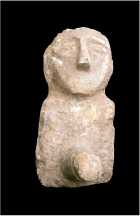
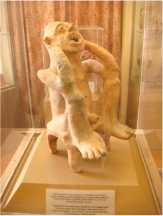
Figure 6a. Sculpture of Gobekli-Tepe Figure 6b. Terracotta figurine in Cyprus
As already it has been mentioned, man for his own survival gave up violent battles, replacing them with the dance-fight, during which the woman chose the man winner. For the more authentic reproduction of fights they used stones symbolising hunters, animals, mountains, caves, etc. Thus dolmens, cromlechs and menhirs appeared, becoming the stage or decoration of the first theatrical performances, where nature served as a model. Megaliths, being the first creation of civilized man, were already being created at the dawn of civilization (more than a hundred thousand years ago). The need to create megaliths appeared in the transition from human-animal to civilized man.
Back to the subject of ancient theatrical performances, it should be noted that spectators gradually began to identify the actors with their roles. Animals acquired the language and characteristics of men, and vice versa, the qualities of men were identified with the characteristics of animals. Even today people say: as fast as a hare, as strong as an ox, as fat as a boar, etc. The next generations, unaware of the origins of this phenomenon, extended the identification to the family, relations, and so up to the state.
The origins of such rituals connected with the victory of man-animal over man-hunter can be traced in theatrical action. The audience felt that women had to copulate with an animal, not with a man. Initially, this was perceived literally, but the next generations turned it into a ritual. The famous Lion of Babylon was traditionally regarded as a symbol of the power of this ancient kingdom (See Fig. 7a). In my opinion, the story of this sculptured image is identical to the well-known Greek myth of Pasiphae’s copulation with the bull (See Fig. 7b).
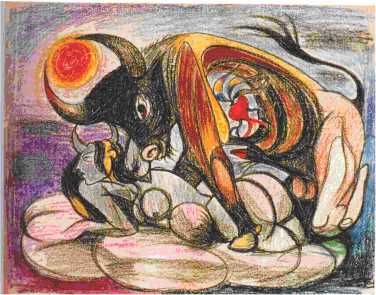
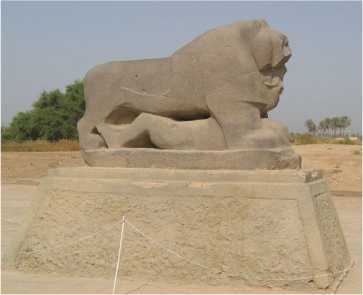
Figure 7a.. The Lion of Babylon
Figure 7b. Pablo Picasso «Suite vollard».
A woman and a lion, Pasiphae and the bull – in fact, these are traditional couples, formed as a result of ancient theatrical performances.
When man became civilized, there appeared a gap between the symbol and the symbolized, and megaliths turned into an end in itself and a tradition for subsequent generations. Every generation created its “megaliths”. Their original purpose was forgotten. They transformed into ziggurats, pyramids, theatre buildings , stadiums, etc. They were used for burials, worship, entertainment, etc. All the spiritual practices that evolved around the megalithic structures required a high level of abstract thinking, which was not inherent in man during the transition from human-animal to civilized man.
Thus, the dance-battle in which the woman chose the man and which took place round the dolmen gradually became traditional and turned into a ritual. This happened later, when the real meaning of the dance was forgotten and dance acquired a symbolic significance. The reason for this transformation was in the fact that civilized man lost the need for an initial choice.
In subsequent generations, the ritual became a theatrical performance, but already with a script, director and other attributes and public tournament. This is how the peculiar evolution of dance-fight took place.
If we consider such megalithic structures as cromlechs, we can find the striking similarity of their organization with the arrangement of the ancient theater.

Figure 8. Stonehenge.
Figure 9. Ancient theatre.
Let’s consider the describing of Ancient Theater in J. E. Harrison’s book (Fig. 8, 9): «The orchestra on which the Dithyramb was danced was just a circular dancing-place beaten flat for the convenience of the dancers, and sometimes edged by a stone basement to mark the circle» [8, p. 124].
In the fragment below the details also are seen, allowing to draw analogies between places of the first theatrical performances and the Ancient theatre. «The orchestra here is surrounded by a splendid theatron , or spectator place, with seats rising tier above tier. If we want to realize the primitive Greek orchestra or dancing-place, we must think these stone seats away… The dance tends to be circular because it is round some sacred thing, at first a maypole, or the reaped corn, later the figure of a god or his altar. On this dancing-place the whole body of worshippers would gather…» [8, pp. 124–126] (Fig. 10 a, b, c). Harrison pays attention to the fact, that there is no division at first between actors and spectators; at initiation ceremonies the whole tribe assembles. The only spectators are the uninitiated, the women and children. No one at this early stage thinks of building a theatre , a spectator place. It was «in the common act, the common or collective emotion, that ritual starts» [8, p. 126].

а. b. c.
Figure 10. Today in Greece. At the floor, used for dance, the whole crowd of spectators can take places.
The tournament is also a kind of performances which were born from dancebattle, with that only a difference from theatrical performances, that final in sport is unknown (Fig. 11, 12).

Figure 11. Football team

Figure 12. Theatrical company
Conclusion
As Manolis Glezos wrote: “There is already evidence – archaeological researches and contemporary primitive peoples – convincing that before going hunting, man performed a special ritual for luck. Special songs preceded the deed. They were uttered as an element of the magical power, so that the mission could be a success” [6, p. 115].
But, I suppose, ’the primitive man’ did not believe in anything else, but in his own survival and the survival of the genus. I believe that so called “rituals” and “magical forces” were a way of selection of the man heroes. So I came to conclusion that Darwin’s ideas are important if we consider the transformation of natural selection principle in the context of civilization.
Список литературы Unpredictable creation of theater in the context of evolution theory
- Bronowski J. (1987). The evolution of human (Η εξέλιξη του ανθρώπου). Athens: Orora.
- Darwin Ch. (1997). The origin of the species (Η Καταγωγή των Ειδών). Patra Hellas: University of Patra Press.
- Davis W. (2011), A general theory of Visual Culture. Princeton NJ: Princeton University Press.
- Deleuze G. & Guattari F., (Делез Ж. & Гваттари Ф). (1998), What is Philosophy? (Что такое философия?). -S.Peterburg: Aleteyl (Алетейя).
- Gaarder J. (1994), The world of wisdom (Ο Κόσμος της Σοφίας), Athens: Nea Sinora.
- Glesos M. (1977), The Phenomenon of Language Alienation (Το φαινόμενο της αλλωτρίωσης της γλώσσας), Athens: Vegas.
- Har M. (1998), The work of art (Το έργο τέχνης), Athens: Scriptra.
- Harrison J. E. (1913), Ancient Art and Ritual, London, Thornton Butterworth Ltd.
- Heidegger M. (1986), The origin of the work of art (Η καταγωγή του έργου τέχνης), Athens: Dodoni.
- Huizinga (Хейзинга Й.) (1997), Homo Ludens; (Статьи по истории культуры, trans. ст. Д. В. Сильвестрова, Коммент. Д. Э. Харитоновича), Moskow: Progress:Traditsia (Прогресс-Традиция).
- Leroi-Gourhan A. (1993). The religions of prehistory (Οι θρησκείες της προϊστορίας). Athens: Kardamitsa.
- Maritsas C., (Μαρίτσας Κ.) (2003), Civilization and natural selection (Πολιτισμός και φυσική επιλογή). Athens: Arsenidis.
- Maritsas C. (Μαρίτσας Κ.) (2007). Civilization and natural selection 2 (Πολιτισμός και φυσική επιλογή 2). Sofia: Sofia University Press.
- Morris D. J., Human Observation -Human Behavior (Ανθρωποπαρατήρηση), Athens: Arsenidis.
- Morris D. J. (1970). The naked ape. (Ο γυμνός πύθικος) Athens: Kedros.
- Peters J., & Schmidt K. (2004). Animals in the symbolic world of pre-Pottery Neolithic Gobekli Tepe, south-eastern Turkey: A preliminary assessment. Anthropozoologica, 39(1), 179-218.
- Taine H. (1998). Philosophy of art (Φιλοσοφία της τέχνης), Athens: Govostis.

